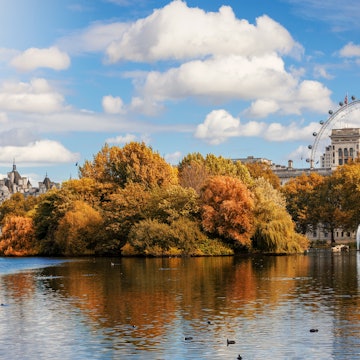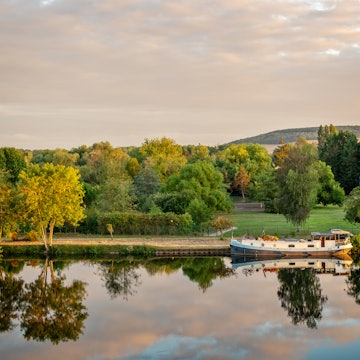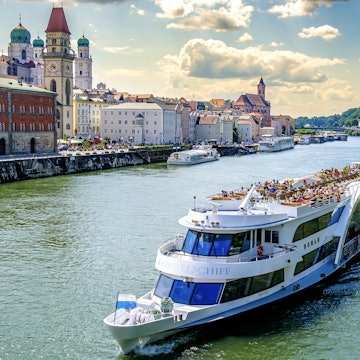

A lighthouse on the sand dunes of Sylt, North Frisian Islands © Jenny Sturm / Shutterstock
Germany may not be one of the first destinations you think of when considering a beach holiday, but it has over 1400 miles (2250km) of coastline on both the Baltic and North Seas, wonderful lakes with sandy coves, and artificial city beaches.
From the seaside resorts with hot saunas to warm you up before a naked dash into the cold sea, to the secluded lakeside sandy spots, perfect for kayaking and SUP, here are Germany's best beaches.
Editor's note: during COVID-19 there may be additional travel restrictions. Check the latest guidance in Germany before planning a trip, and always follow local government health advice. Some attractions may be closed.
Strandbad Wannsee
This lakeside public beach in Wannsee has delighted aquaphiles for more than a century. Although 1km long, the broad sandy strip can get very busy on hot days, especially on weekends. Besides swimming, you can rent boats, play volleyball, basketball or table tennis or grab a snack or drink. Note that the northern end of the beach is reserved for nude bathing.

Kühlungsborn
Kühlungsborn, the biggest Baltic Sea resort, with some 7500 inhabitants, has some lovely art deco buildings backing the long beach and adjoining a dense 130-hectare forest. The east and west ends of the sand are linked by the Ostseeallee promenade, lined with hotels and restaurants.
Heiligendamm
The "white town on the sea", also on the Baltic Coast, is Germany’s oldest seaside resort, founded in 1793. It was fashionable throughout the 19th century as a playground of the nobility. You can’t miss the five gleaming white, heritage-listed buildings of the Grand Hotel Heiligendamm perched nearly on the beach. Sunshine is possible; warm weather is rare.

Titisee-Neustadt
Titisee, in southwest Germany, is a cheerful summertime playground with a name that makes English-speaking travelers giggle. The iridescent blue-green glacial lake, rimmed by forest, has everyone diving for their cameras or into the ice-cool water. Though a tad on the touristy side in the peak months, a quick stroll along these shores brings you to quiet bays and woodland trails that are blissfully crowd-free.
The Strandbad Titisee (Strandbadstrasse 1; Jun-Sep) lake-front lido has a pool and children’s pool, a slide, floating raft and a volleyball area, as well as lawns for sunbathing.
Chiemsee
The Chiemsee is Bavaria’s biggest lake (if you don’t count Bodensee, which is only partially in the state) and its natural beauty and water sports make the area popular with de-stressing city dwellers – many affluent Munich residents own weekend retreats by its shimmering waters. However, the vast majority of foreign visitors arrive at the shores of the Bavarian Sea – as Chiemsee is often called – in search of King Ludwig II’s Schloss Herrenchiemsee.
The towns of Prien am Chiemsee and, about 5km south, Bernau am Chiemsee (both on the Munich–Salzburg rail line) are good bases for exploring the lake. Of the two towns, Prien is by far the larger and livelier. The swimming beaches at Chieming and Gstadt (both free) are the easiest to reach, on the lake’s eastern and northern shores respectively. A variety of boats are available for hire at many beaches.
Maschsee, Hanover
This artificial lake, built by the unemployed in one of the earliest Nazi-led public-works projects, is now a favorite spot for boating and swimming. It’s certainly the most central, at just 30 minutes’ walk from the Hauptbahnhof and directly alongside the HDI Arena, Hanover’s football stadium. Ferries – some solar-powered – ply the lake from Easter to October in good weather, and there are sailing, pedal and rowing boats for hire.
Schluchsee
Photogenically poised above its namesake lake – the Black Forest’s largest – and rimmed by forest, Schluchsee tempts you outdoors with pursuits such as swimming, windsurfing, hiking, cycling and, ahem, skinny-dipping from the secluded bays on the western shore. The otherwise sleepy resort jolts to life with sunseekers in summer and cross-country skiers in winter.
Aqua Fun Strandbad is popular with families, this lake-front lido has a heated pool, water slide and rapid river, a sandy beach and a volleyball court.

Warnemünde
Warnemünde, near the port city of Rostock, is all about promenading, eating fish, sipping cocktails, and lazing in a Strandkorb (sheltered straw "beach basket" seat) on its long, wide and startlingly white beach. For a fabulous view from above, climb the spiralling 135-step wrought-iron and granite staircase of the 1898-built lighthouse.
East Frisian Islands
Lined up in an archipelago off the northern coast of Lower Saxony like diamonds in a tiara, the seven East Frisian Islands, with their long sandy beaches, open spaces and sea air, are both a nature-lovers’ paradise and a perfect retreat for those escaping the stresses of the world.
Trying to remember the islands' sequence, Germans – with a wink of the eye – recite the following mnemonic device: "Welcher Seemann liegt bei Nanni im Bett?" (which translates rather saucily as "Which seaman is lying in bed with Nanni?"). The islands are (from east to west): Wangerooge, Spiekeroog, Langeoog, Baltrum, Norderney, Juist and Borkum.
Langeoog is your best bet if you're looking for a quiet, day-return beach trip. On a sunny day, the most popular thing to do there is to stroll along the 14km-long beach. The main tourist season here runs from mid-May to September.

Sylt, North Frisian Islands
Glamorous Sylt (38.5km long and only 700m wide at its narrowest point) is the star of Germany's North Frisian Islands. This anchor-shaped island is attached to the mainland by a narrow causeway. On its west coast, the North Sea’s fierce surf and strong winds gnaw at Sylt's shoreline, even as the eastern Wadden Sea shore is tranquil.
Elsewhere, Sylt’s candy-striped lighthouses rise above wide expanses of shifting dunes, fields of gleaming yellow-gold rape flower and tracts of heath. Along the beaches are saunas, where the idea is to heat up and then run naked into the North Sea.
Sylt's windsurfing is known as the most radical on the World Cup windsurfing tour, which finishes here each September when winds and waves are wild. Beginners shouldn’t be deterred. There are water sports schools in every town where you can learn to master kitesurfing, regular surfing, catamaran sailing and much more, as well as rent gear.
You might also like:
Germany's best cycling routes
Germany's most delicious dishes
Germany's 10 most spectacular road trips













